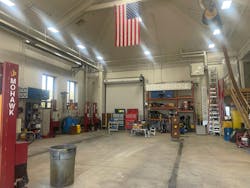Thumbing through the pages of the Station Design Awards entries in the November issue of Firehouse, it occurred to me that I didn’t see any lifts, hose reels or tire storage area, or tool carts. Assorted apparatus, ambulances and other emergency vehicles were in rows on the shiny floors with lines, but no equipment to maintain or work on the emergency vehicles. Not an emergency vehicle technician’s (EVT) office insight.
Is apparatus maintenance not performed in new fire stations? Digging deeper, it turns out, yes, and there are three reasons for the missing equipment in apparatus bays: advanced technology; budgetary restrictions and the lack of EVTs.
In his editorial for the Firehouse April issue, Peter Matthews, editor-in-chief, confirms the advanced technology and the importance of comprehensive planning when purchasing new fire apparatus.
“As new apparatus becomes more sophisticated and connected with technology,” Matthews says, “members of a committee must understand all of the warranties, service contracts and life cycles, so an issue with a small component doesn’t create a long-term out-of-service time in their department’s frontline fleet as the repair is handled.”
Matthews adds, “With increasingly advanced technology being added to make maintenance and operations easier, more wires, more connections and changes to the power are required.”
Maintenance options
Apparatus maintenance depends on the size and location of the department and whether maintenance is performed at a central facility, dealerships, independent shops, or even mobile EVTs. Large city departments can send rigs to the Department of Public Works, however, suburban and smaller departments are left to find affordable options.
Joe Lissman, maintenance director, Lisle-Woodridge, IL, Fire District (LWFD), explained that they have an IGA with Darien-Woodridge Fire District to maintain their apparatus and in Illinois, there is an increase in centralized maintenance facilities for emergency vehicles. Two new centralized facilities in Mundelein and Orland Park now support numerous fire departments in the Chicagoland area.
According to Rob Manns, Manns Woodward Studios, “Our county has just built a new central fleet maintenance facility. They have saved a ton by having diesel and emergency vehicle techs under one roof. They’re able to service anything from a school bus to a ladder truck. Install lights and radios to repair tires. They also have a drafting out for pump test operations.”
Manns recently completed the Harford County Fleet Maintenance Facility, a new 77,600 sq. ft., two-story building in Maryland that has 38 garage maintenance bays.
The project includes the construction of heavy-duty paving and parking areas, new utilities, garage slabs with radiant heat, overhead sectional doors and overhead coiling doors, a fluid distribution system, vehicle lifts and cranes, a compact tire storage system, office partitions, and employee amenities such as break rooms and a kitchen area.
“Some smaller departments have been using mobile mechanics,” Manns said. “Larger departments like Anne Arundel County, MD, are building dedicated fire rescue apparatus maintenance facilities where they also store reserve apparatus.”
Size matters
In the upper Midwest, Robert Krzyzanowski, Five Bugles/Mitchell Associates, explained apparatus maintenance is dependent on the size of the overall community/municipality.
“In any new station design in the Midwest, we provide for the ability to be able to tip the engine cab inside of the station, which takes coordination to ensure the structure is high enough to accomplish this,” Krzyzanowski said. “We have also provided enough space for the ladder truck to be able to swing the ladder to the side so maintenance can be accomplished as well.”
Budgetary restrictions are another factor for consolidating apparatus maintenance. Liability, finding trained emergency vehicle technicians and the increased hourly rates at dealer service centers can be higher versus a consolidated city or county maintenance facility serving multiple emergency service departments.
“As apparatus continues to evolve in terms of sophistication, most clients we work with are limiting maintenance and the associated liability to the absolute basics,” Krzyzanowski added. “There has been an occasional station or two where the department still has a full-time maintenance person on staff. In those instances, we have provided an elaborate maintenance bay and maintenance area for their needs such as welding, grinding, tool storage, part storage, etc. However, this is not often, which I would assume comes down to budgetary reasons for each department.”
With the Call for Entries for the 2024 Station Design Awards program just announced, we look forward to seeing what other changes we’ll see in fire stations. We’re already aware of the consolidated cleaning of turnout gear, but what other options will save time and money as budget restrictions continue?
About the Author
Janet A. Wilmoth
Special Projects Director
Janet Wilmoth grew up in a family of firefighters in a suburb of Chicago. Wilmoth, who is owner of Wilmoth Associates, worked with Fire Chief magazine for 27 years until it closed in 2013. She currently is the project director for Firehouse, overseeing the Station Design Conference.

